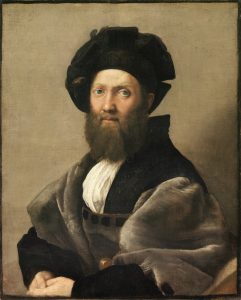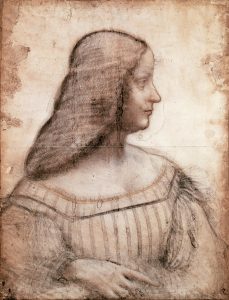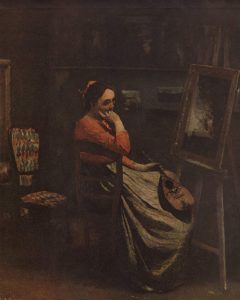
Like knowledge itself, the subject of art must be everything—including us—in all of its manifestations, expressed in sensory response, like the sound of an anvil under the blows of a hammer. For too long the contortions and confinements of religious iconography, refined this way and that, were served up to us to satisfy our desire for learning and for the joys of feeling. Think about the stupefying limitation of subject-matter that shackled painting in the Renaissance. Christianity and classical polytheism provided a trove of myths and legends that were taken as “history”; the natural world was ignored. Only portraiture thrived, because of the impossibility of expunging interest in human beings. The Balthazar of Raphael, Leonardo’s Isabella d’Este—these provide proof. Later on, Rembrandt, with no friends among the princely classes, fell back on dressing himself in exotic costumes and seeking humanity in the mirror.
Now, however, we have reached a stage in our consciousness wherein science and art, though worlds apart as pursuits, have this in common: an intense interest in sensory response. Our scientists scrutinize sensation in search of evidence for broader theories; the artist, for his part, trusts to emotional experience, to intimations of order and harmony, to realize, as completely and as well as he can, the sensory encounter with life.

Because these are, after all, the manifold reactions of living creatures, an array of feelings and perceptions triggered by and proportionate to external stimuli, I need to limit my attention here to the dynamics of seeing; in other words, one special order of biological and neurological experience. Everyone knows that the art of painting tries to show us the visible world as a symphony of hues, just as music offers us harmonies of sound. Such basic recognitions, long before there was any theorizing on these subjects, fostered the first cave-wall images in the Stone Age and moved shepherds, ages ago, to launch songs onto the errant winds to call their flocks together. What we celebrate as light is only one form of energy, vibrations of a certain amplitude and speed. The universe appears to us as a tempest of waves, colliding or intensifying for momentary effect, an endless flux of lost hopes and ephemeral illusions; only Lethe, dark stream of eternity and forgetfulness, bears witness to it all. Even so, because so much is going on, immense discords and moments of coherence, it can happen that corresponding wonders can unfold within the seer, even if only for an instant, setting off a process that will eventually draw in all the higher faculties, the entire personality. This is the stuff of legend, tales of the imagination taking dominion over the world beyond the self. We find it as far back as the chants of primitive man, where incantations control what unfolds in the moment of the song. We also see it in real life. Claude Monet, for instance.
Wait—how can I bring Monet into musings like this? Why not Leonardo da Vinci instead, or Michelangelo, or Rembrandt, all of whom would work better here not only because they are long gone, but also because their status as Old Masters is beyond question? The answer is that Monet is someone I knew, an artist whose skills I could size up again and again, in all those first-hand encounters with his passionate innocence; a man that I loved; a man I love still; I man I want to bring back to life, here in this shimmering sunlight, the realm where he became the genius who dreamed and made those dreams come true.

We remember Leonardo as an artist who knew everything, understood everything, and also did practically everything. Nonetheless, there is no indication that his experiences with light itself ever moved him all the way to rapture. Like so many others of his time he preferred sunsets and twilights, to help him catch, with subtle brushstrokes, the lovely contours of the Mona Lisa’s face. For us the effect is compounded now by the darkening of the varnish on the canvas; though this face is supposedly out in the air, we see it in penumbra. Years ago, when Monet and I were looking at Corot’s Woman with a Mandolin—one of the most beautiful works we have—he said to me (when he was sure that no one else was listening), “I like this better than La Gioconda.”
His point was that for all of Leonardo’s genius, he could not escape from the traditional indoor lighting of the atelier; the rustic Frenchman Corot, however, working without a theory, without a set of rules, and also (dare I say it) without formal training, gave himself over to representing, faithfully, the light of the skies as it really is. (To be fair to Leonardo: in his fabulous line-drawing of Isabelle d’Este, the illumination does play a fundamental role, though the source of that light is left as a mystery.)
Of course it’s presumptuous for someone like me to generalize about these masters with such abandon. My only excuse for this is my one and only qualification—my many years as a spectator. I am part of the mass audience, after all; and for me, as for countless others, the likes of Phidias, Michelangelo, Raphael, Leonardo, Rembrandt, Velázquez, Frans Hals, Goya, and other great artists all did their work. Ultimately they are all subject to the judgment of the world. All the greats of every age have had to trust us in giving their best; what greater homage can we give them than our sincerest response?
Engineer, poet, sculptor, painter—Michelangelo was an incomparable genius, taking on great challenges and often meeting them or coming close. His Moses owes nothing to Hellenistic sculpture; the shock one feels upon seeing this “monster” cannot be forgotten. And about the Sistine Chapel, what could we say that wouldn’t be paltry and banal, about this panorama of superhuman figures, swept into the heavens by relentless storms of sublime imagining! Magnificent in every realm he entered, Michelangelo takes dominion everywhere; more than royalty, he was almost divine. Also blessed by some unknown god, Rembrandt could find in a flash the perfect way to express insights of astounding intensity. At the museum in Cassel there is a series of his sketches in which one looks for, and often finds, the kind of shimmering that foreshadows a blast of lightning. Syndics of the Drapers Guild is the work of a giant, a master of the heavenly spectrum, working with the sun indoors as well as out, and finding in his subjects the essence of a thunderbolt.
When there was no one else to paint, Rembrandt would turn to his own reflection in any handy mirror, experimenting with brush or etching tools with every kind of lighting. Our ever-curious Dutchman was never fazed by the endless marvels around him. Like Monet much later, Rembrandt responded all-out to the challenges of light, and in this heroic, physical contest he was able to win. Even so, it doesn’t seem that he ever got as far as he dreamed of going: we sense him battering with his bare fists against shadow and darkness, striking sparks of a heavenly fire whose mysteries he had glimpsed as his own brush cut this way and that, to catch and calm an ecstasy of seeing. In his violent contrasts of light and darkness we feel a heat shoot forth as if from a furnace—all this transparent light, here blended and there distinct, these subtle waves of illumination, producing sensations that painting had never achieved before.
It was miraculous, like Monet’s Nymphéas, mirrored in the water-garden, voluptuously asleep in the bosom of the clouds. An encounter with a world turned upside down, made unfamiliar, inducing the eye to mediate these waves of color, symphonically blended. Drawing us into the most elegant webs of visual experience, this novel adventure for the eyes rewards our effort by enriching our powers of perception.
Rembrandt is an artist who expresses himself in contrasts and oppositions. With his water-lilies, Monet took a different path, a narrow one of close observations, fine distinctions. Having studied the shifting light upon the wheat-stacks and the cathedral facades and the river scenes at Westminster, he came to his day of discovery at Giverny, seeing there, in the still waters of the river Epte, the intricate play of sunlight that brought him to his supreme effort of interpretation. Mortally ill and in his final days, consoling himself with a gathering dusk that his mind was still exploring for hints of hue, did he think about his life’s work and risk some final, personal judgment of it all? I have no idea. I do know that he was too honest to ever let go of the anguish of his doubts, and too great an artist to ever feel entirely satisfied, puzzled as he sometimes was by mindless critique from the public.
I mentioned to him one day that while passing through the town of Vitré I had stopped a nattily-dressed young bourgeois on the sidewalk, to ask him the way to Les Rochers, the château of Madame de Sévigné.
“I am sorry monsieur, but I think you’re mistaken; there is no such place here,” I was surprised to hear him say.
“I beg your pardon, monsieur, but I think it is you who are mistaken. I know there’s a statue of her here in Vitré.”
“Oh, you mean the bronze lady in the Jardin des Plantes? Well, to get to the gardens you make a right turn…”
“Such is fame, eh?” cried Monet.
“That’s it. So tell me, what recompense are you after?”
He burst out laughing; nearby on his cushion, the cat slept through it all—for being a Chinese porcelain cat, it felt no obligation to stir for such nonsense. The brushes were soon picked up again, and the long and difficult ascent resumed.
Having spoken of the immense and painstaking effort to educate the modern consciousness, how can I avoid saying more about the artist at work? Into his paintings Monet put the very best of himself, and in these paintings he comes back to us. For as we chronicle our own passage through the chaos of the spheres—sometimes in action, sometimes only bearing witness—nothing can be more precious to us, in our reckoning with ourselves, than experiences like these, of the thoughts and deeds of companions on this journey, helping us map the rise in our collective capacity to feel.
We experience the world only through whatever our five senses can bring in, and as for our struggles to catch the motions of light itself, they go all the way back, as I’ve said, to the very first paintings in prehistoric times. That was our opening attempt to understand the external, and ever since we have not ceased to reach out, to pursue the endless enticements of space and time. Because the art we encounter is the vibrant source of our negotiation of the world and also of ourselves, we never cease to draw from them subtle hints of some deep and universal order, sanctifying our encounter with an experience of sheer beauty.
But the light of the world will never keep still, the spectrum scattering and recomposing constantly and all around. To engage it, the painter must commit to a life in close combat, expressing what he sees with constructs that have no existence in the natural world, juxtaposing and mixing and layering colors to catch effects of light that can never be more than momentary.
No matter how we look at it, this contingent, relative life of ours will always be in conflict with the monstrous Absolute, and the best we can do is to speak of it, if we cannot truly apprehend it. To go that far we would require much more than words and categories, for too often they fool us into accepting some transient or partial truth as a dogma to be trusted. How much truth, known or hidden, would we need to acquire even to begin a project like that?
I hope you’ll excuse these thoughts along the way, matters that Monet didn’t have to contemplate because they weren’t in his realm. Even so, they lie in the path of anyone who hopes to give the arts their due as a great adventure of mankind.



